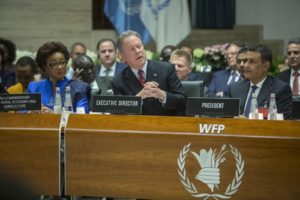
Rome, Italy, October 17, 2017– The Executive Director of the United Nations World Food Programme today made an impassioned plea for peace amid mounting evidence of the links between conflict, migration and rising hunger.
Concerns are growing that progress in defeating global hunger is being reversed as record numbers of people flee their homes to escape fighting.
“Someday in the future, World Food Day will be a celebration of a peaceful and well-fed world. Sadly, that day seems very far off right now. We have far too much violence and conflict, and that is why we have more people who are hungry and in need of assistance,” said WFP Executive Director David Beasley.
After steadily declining for over a decade, hunger is on the rise again and of the 815 million hungry people on the planet, 489 million live in countries affected by conflict, the annual UN report on food security and nutrition revealed last month.
“I call on the people in power, the people with guns, to stop the fighting now,” said Beasley, who has met many people fleeing conflict and violence in Yemen, South Sudan and Bangladesh over the past few months. “I saw their wounds with my own eyes and I heard their stories with my own ears. They were frightened, hungry and malnourished after enduring a nightmare that most people cannot even imagine. If we are truly going to end hunger, we must stop this kind of inhumanity.”
The State of Food Security and Nutrition in the World 2017 report found that while most countries had achieved significant gains in reducing hunger in the last 25 years, progress in the majority of countries affected by conflict had stagnated or deteriorated. Conflicts can devastate the economy, disrupt agriculture and lead to forced population movements.
A WFP study published earlier this year established a link between hunger and migration. It found that countries with the highest level of hunger, coupled with armed conflict, have the highest outward migration. For each additional year of conflict and bloodshed, an extra 40 people out of 10,000 will flee their country. It showed that people often move several times within their own country before crossing borders, leaving behind their land, jobs and livelihoods.
In northern Ghana, long dry spells and a single rainy season, cause rural-urban migration among people who depend on agriculture and natural resources for a living. Similar to the Government of Ghana’s proposed One Village, One Dam initiative, WFP’s asset creation programme helps people to build small dams, fish ponds and other structures that are needed to improve their lives. This helps communities to work and earn an income all year round.
In war-torn countries, where agriculture and trade is disrupted and the economy collapses, the cost of a simple, nutritious plate of food can be more than a day’s wages.
WFP has developed an index where we have worked out the cost of a basic plate of food to people in 33 developing countries as a share of their average daily income. In Counting the Beans: The True Cost of a Plate of Food around the World, we show that in South Sudan, for example, the cost could be the equivalent of a New Yorker having to pay US$321 for a modest lunch – say a plate of bean stew — cooked at home. At the height of the siege of the Syrian town of Deir Ezzor, the same meal worked out at nearly US$200.
African Eye Report


